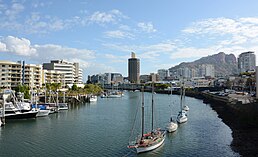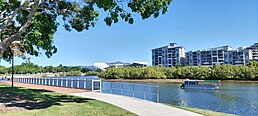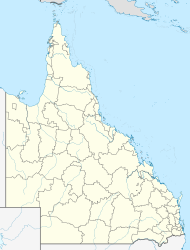
Back Townsville Afrikaans تاونسفيل Arabic تاونسفيل ARZ تاونزویل AZB Таўнсвіл Byelorussian Таунсвил Bulgarian Townsville Catalan Townsville (lungsod) CEB تاونزڤیل CKB Townsville Czech
| Townsville Queensland | |||||||||
|---|---|---|---|---|---|---|---|---|---|
Townsville waterfront with North Queensland Stadium in the background | |||||||||
 | |||||||||
| Coordinates | 19°15′S 146°49′E / 19.250°S 146.817°E | ||||||||
| Population | 173,724 (UCL 2021)[1][2] | ||||||||
| Established | 1865 | ||||||||
| Postcode(s) | 4810 | ||||||||
| Elevation | 15 m (49 ft) | ||||||||
| Area | 693.3 km2 (267.7 sq mi)[3] (2021 urban) | ||||||||
| Time zone | AEST (UTC+10) | ||||||||
| Location |
| ||||||||
| LGA(s) | City of Townsville | ||||||||
| County | Elphinstone | ||||||||
| State electorate(s) | |||||||||
| Federal division(s) | |||||||||
| |||||||||
Townsville (Bindal: Thul Garrie Waja,[4] Warrongo: Gabilgaba)[5] is a city on the northern east coast of Queensland, Australia. It is the largest regional city in Queensland and in 2010 was made a second capital by Premier Anna Bligh to take the stress of governing off the southeast corner of Queensland. Before the city was made a capital, Townsville was often referred to as the capital of North Queensland, but the split of the state never occurred.
Popular attractions include 'The Strand', a long tropical beach and garden strip; Riverway, a riverfront parkland attraction on the banks of Ross River; Reef HQ, a large tropical aquarium holding many of the Great Barrier Reef's native flora and fauna; the Museum of Tropical Queensland, built around a display of relics from the sunken British warship HMS Pandora; and Magnetic Island, a large neighbouring island, the vast majority of which is national park.
- ↑ Australian Bureau of Statistics (28 June 2022). "Townsville (urban centre and locality)". Australian Census 2021 QuickStats. Retrieved 11 December 2022.
- ↑ Australian Bureau of Statistics (28 June 2022). "Townsville (urban centre and locality)". Australian Census 2021.
- ↑ Australian Bureau of Statistics (28 June 2022). "2021 Community Profiles: Townsville". 2021 Census of Population and Housing. Retrieved 9 August 2023.
- ↑ https://www.townsville.qld.gov.au/about-townsville/history-and-heritage/townsville-history/traditional-landowners
- ↑ https://www.scribd.com/doc/164615998/Grammar-of-Warrongo-Mouton-Grammar-Library-pdf






